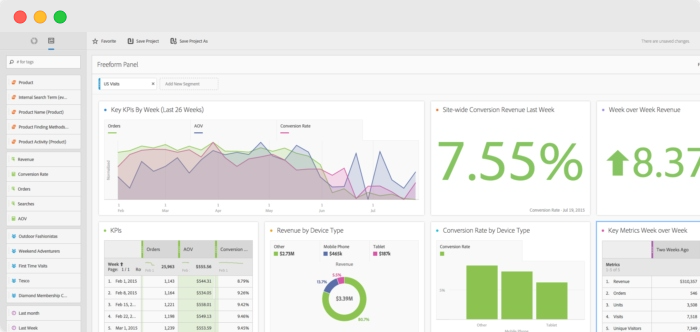Customer journey mapping tools allow support, sales and marketing teams to manage and track cross-channel journeys more cohesively.
Customer journeys are complicated and becoming more drawn out, spanning over months and a multitude of channels.
In fact, in a study, we discovered that 82% of sales cycles last up to 4 months, and 18% can take 4+ months to close.
With customer journey mapping tools, you can gain a deeper understanding of your users and unlock valuable data about their interactions and behaviours.
But, with so many tools available, how do you know which one is the best fit for you?
To help you decide, we’ve picked a few favourites we think will best serve your needs.
For this article, we’ll discuss:
Pro Tip 🚀
Tracking customer interactions across multiple channels unlocks powerful insight which you can use to improve your customer experience and marketing efforts.
Download our guide on how to track customer journeys and learn how to follow the complete lifecycle from awareness to loyalty.
Essentially, customer journey mapping tools let marketing, sales, and customer support teams connect user touchpoints across multiple channels and stages.
Related: Guide to customer journey stages and how to track them
They collect key information about your customers, such as how they found you, what pages they looked at and what actions they took on your website.
When used correctly, customer journey mapping tools can help you understand how different marketing and sales channels impact your traffic, conversions, customer experiences and more.
Customer journey mapping tools give you a complete picture of your overall performance.
They help tie customer journeys to wider business outcomes to measure and track revenue, profitability and other overarching metrics on which you and your other teams are measured.
The best customer journey mapping tools even allow you to confront the most complex questions commonly asked by company executives and clients, such as:
Customer journey mapping tools let you link customer experiences to quantitative metrics in a way that traditional analytics can’t.
In this survey, 81% of business decision-makers revealed that they’re dissatisfied with the speed at which analytics are delivered today, and 69% are dissatisfied with the quality of work.
At this point, you’re probably wondering why.
The answer?
It helps if we discuss some of the main barriers of traditional analytics.
The customer journey has changed a lot over the last decade.
It’s become long and complicated.
On average, consumers use ten different channels to communicate with companies before converting into a customer.
Most marketers will turn to tools like Google Analytics in an attempt to map and analyse specific user journeys. But, the issue with most traditional analytics tools is that the data is aggregated and anonymised.
Related: Limitations of Google Analytics
In other words, you’re not able to find a specific user, where they came from, or what they did on your website.
Without individual data points, the process of tracking users across the customer journey is pretty much impossible.
Thankfully, there are plenty of customer journey mapping tools that can help you face this challenge head-on.
Here’s some good news.
The data you need to connect the dots throughout the customer journey does exist.
It’s just locked away in other systems.
Great, so what is the issue?
Manually extracting data from your analytics and other data points, such as your CRM, is labour-intensive.
It’s not something that can be accomplished on a whim. Data migration requires extensive expert guidance, time, and money that most businesses don’t have.
Related: How to integrate CRM data with Google Analytics
Even if you manage to integrate your data, it’s likely inaccurate, as there is a difference in the way a ‘user’ is recorded in Google Analytics and your other applications.
Pro Tip 🚀
Ruler Analytics connects the dots between your marketing touchpoints and sales data in the CRM, allowing you to track which marketing channels have the greatest impact on revenue. Download the closed-loop marketing attribution eBook to learn more.
Customer journey mapping tools can often mean different things to different people. To help simplify this, we’ve divided our list of customer journey mapping tools into two categories.
Customer journey analytics tools: Unlike traditional analytics, customer journey tools focus on the bigger picture and let you combine your marketing, sales and customer data to create a single view of your user journeys and interactions.
Customer behavioural tracking tools: As it says on the tin, behavioural tracking tools allow teams to measure, track and analyse the behaviour of users and are great for identifying opportunities to improve customer experiences.
Choosing the right customer journey mapping tool is tough, as no solution fits every need.
However, if you intend to track multiple touchpoints and channels for leads and visitors, then you’re best sticking with customer journey analytics.
On the other hand, if you want a solution to track customer engagement and usage, you can’t beat a good customer behavioural tracking tool.
With the right customer journey analytics tool at your disposal, you can seamlessly track and analyse lead and customer touchpoints across the entire user journey. Let’s look at several tools to guide you on your quest.
We couldn’t write about customer journey analytics tools and not mention Ruler.
Read more: How to view full customer journeys with Ruler
Ruler is a closed-loop marketing attribution solution that aligns marketing source data with revenue in your CRM. It tracks your visitors touchpoints–online and offline–to measure and attribute value accurately across the entire customer journey.
The tool works by tracking each anonymous visitor over multiple sessions, traffic source, keywords and more.
When an anonymous visitor converts into a lead, Ruler matches the user’s details to their marketing touchpoints. A lead could convert over the phone, form or live chat, but Ruler can easily track and record these interactions.
Once Ruler has matched the conversion details with the user’s touchpoints, that data is then sent to your CRM. This populates the sales team’s system with conversion and marketing data, which helps them learn more about each prospect before reaching out to them.
When a lead closes into revenue, the value from the deal is sent back to the Ruler dashboard. Here, you can measure the impact of your marketing sources, campaigns, keywords and ads based on how much revenue they’ve contributed to your business.
Read more: How Ruler attributes revenue to your marketing leads

Our tool provides a list of features that can help you map and better understand your customer journeys.
Pricing for Ruler starts at £199 a month and it has various plans to suit your specific needs. You can save 20% by paying annually and there are special rates for agency partners.
Pro Tip 🚀
Want to better understand your website visitors and measure the performance of your marketing campaigns more effectively? Book a demo of Ruler and see how it works for yourself.
Customer journey analytics provides a toolkit to business intelligence and data science teams that help them stitch and analyse cross-channel data. Its capabilities deliver context and clarity to the complex multi-channel customer journey.

Price: Contact for information.
Alterian’s Journey Analytics allows brands to see actual journeys and drill into the performance of particular initiatives. Companies can track and measure where customers drop out of a journey and understand why they didn’t reach their intended objective.

Price: Available on request.
Heap is an analytics platform that helps product, marketing, and customer success teams create personalised digital experiences that help convert and retain more customers.

Price: Available on request
Nexidia Analytics enables you to track and understand the customer’s entire journey across all touchpoints. It provides you with insights to help improve the quality and effectiveness of your interactions.

Price: Available on request.
Optimove processes all customer data into a single customer view to make it easily accessible to non-technical users, while also providing smart insights to help better understand your customers and optimise for better quality.

Price: From $4,000/month.
Woopra is a customer journey analytics solution that is redefining how companies understand, analyse, and retain their customers. It allows you to leverage individual-level data to aggregate analytics reports for full lifecycle insights to help bridge departmental gaps.

Price: From $999/month.
Tracking customer behaviourbehavior across the sales and marketing funnel is important. When you understand what your customers are looking for, you can adjust your marketing and services accordingly to better meet their needs. Below are a few customer behavioural tracking tools to help get you started:.
Crazy Egg is a powerful solution that allows you to explore the in-page interactions of your website visitors and customers. It offers click heatmaps, scroll heatmaps, movement heatmaps, and attention heatmaps.

Pricing: Basic package starting at $24/month
Hotjar is another heat mapping solution that businesses can use to track users’ interactions and behaviours. It allows you to track click, tap, scroll and mouse movements. Ideal if you want to improve your UX and conversion rates.

Pricing: Free for the first 1,000 pageviews/heatmap. Then from €39/month
Mouseflow is a behavioural analytics tool that helps improve your website and customer experiences. It provides standard features such as heat mapping and journey recording, but also provides insight into why users are abandoning your forms.

Pricing: Freemium option available.
Smaply is a powerful journey mapping and persona creation tool. It helps track your customer characteristics and needs. Useful if you’re looking to optimise your products and services towards customer interests and buying habits.

Pricing: Freemium option available.
Modern companies are using customer journey mapping tools to understand behaviours and confront the most difficult questions asked by company executives and clients.
Using tools like Ruler, you too can help you unlock valuable data across the entire buying cycle, identify your most profitable campaigns, and if used correctly, can significantly increase your ROI.
Want more info? Book a demo of Ruler and see how it tracks your customer journeys and attributes revenue to your marketing leads.
